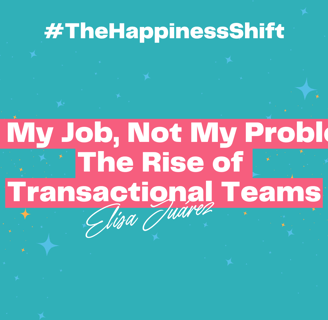Not My Job, Not My Problem: The Rise of Transactional Teams
As boundary culture grows, some teams are becoming more siloed and transactional. Learn how to rebuild collaboration and shared ownership at work.
Elisa Juarez
5/15/20251 min read
In a post-pandemic world, the language of self-care and boundary-setting has become common in the workplace. For the most part, this is progress. Employees are finally saying no to toxic hustle culture and yes to protecting their energy.
But in some companies, another shift is unfolding—the rise of transactional teams.
You may hear it in subtle ways:
“That’s not my department.”
“I don’t get paid to do that.”
“I’m staying in my lane.”
What begins as healthy boundary-setting can, in time, erode collaboration, ownership, and innovation.
When Boundaries Become Barriers
A 2023 report from Gallup found that over 50% of U.S. employees are not engaged at work. Many are operating in what’s now called “quiet quitting”—doing only what’s required, no more, no less. In some cases, this is a protective response to burnout or feeling underappreciated. But when it becomes a team-wide norm, it can undermine culture.
Transactional teams are marked by:
Rigid adherence to job descriptions
A lack of cross-functional support or initiative
Minimal emotional investment in collective outcomes
This doesn’t mean people are lazy—it often means they’re cautious. Tired. Disillusioned. But when no one feels empowered (or safe) to step up, the ripple effects are felt in productivity, morale, and retention.
So What Can Leaders Do?
If you’re noticing signs of disengagement wrapped in boundary language, here are three questions to reflect on:
Do people feel psychologically safe to try—and fail?
Teams that feel punished for stepping outside the box will stay in it.Are roles clear and flexible?
Structure matters, but so does a sense of shared purpose and adaptability.Are wins shared—and recognized?
Employees need to know their contributions matter. Recognition fuels ownership.
A Practitioner’s Perspective
As someone who supports companies in building cultures of belonging and well-being, I see this overcorrection everywhere. People are craving more balance—but also more meaning. And often, those two ideas feel at odds.
The solution isn’t pushing people harder. It’s creating conditions where they want to contribute again. Where showing up for the team doesn’t feel like a sacrifice, but a shared success.
Let’s Keep Talking
Have you experienced this in your workplace?
Have boundaries made your team stronger—or more disconnected?
👇 Join the conversation in the comments or subscribe to The Happiness Shift newsletter for more weekly reflections.


Address
Miami, FL
